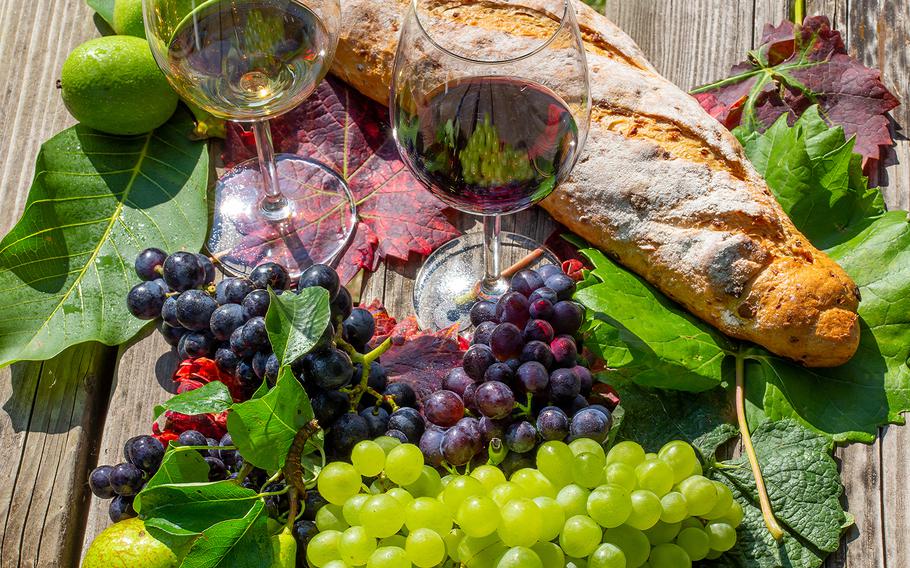
Celebrate Germany’s finest wines at any number of almost-fall festivals. (iStock)
While Germany’s known as a land of beer, the country’s ability to produce some of the world’s most highly regarded wines, particularly whites, is no less cause for celebration. And celebrate they do, particularly as harvest time draws near. Germany’s wines are produced in 13 officially designated wine regions, all but two of which are clustered in the southwest of the country. Here’s a look, by region, at some upcoming wine festivals sure to make the waning days of summer all the more memorable:
Rheingau: The Rheingau wine-growing region, stretching along the Rhine roughly between Wiesbaden and Rüdesheim, is known for scenic vistas and stellar wines, particularly its Rieslings. These wines are just one of the many attractions of the Rheingauer Weinwoche, 10 days given to celebrating wine culture in the heart of Hesse’s capital of Wiesbaden. In the shadow of the towering, neo-Gothic red brick market church, the masses come out to enjoy thirst-quenching white wines and spritzers, sparkling Sekts, gourmet fare and live music in styles ranging from Latin jazz to Irish dance. This year’s edition of the fest continues through Aug. 17. Online: tinyurl.com/3hddb5wr
Rheinhessen: Located to the west of the Rhine between Mainz and Worms, Rheinhessen, Germany’s largest wine-growing region, produces mostly white wines, among them Riesling, Müller-Thurgau and Silvaner. Sampling a great cross-section of these varieties is made easy by attending the Mainzer Weinmarkt, a wine fest set in a verdant park on the outskirts of town. From Aug. 28-31 and Sept. 4-7, thousands of visitors will linger at wine stands, snack on typical treats, dance to live music or just sit on a blanket on the grass and watch the world go by. Unique features of this wine fest include an artist’s market set in a rose garden and a children’s zone offering crafts, face painting and other fun (Sundays only). Online: mainzer-weinmarkt.de
Mosel: Germany’s oldest winemaking region features a twisting, turning river, idyllic villages and astoundingly steep slopes. The region produces mostly whites, Rieslings in particular; those grown on slate soil have a distinctive, mineral taste. A great place to try them is Bernkastel-Kues, a town bursting with half-timbered houses and medieval flair, as it plays host to the Middle Mosel Wine Festival Sept. 4-8. The region’s largest fest is made up of not only the usual stands offering food and drink but several one-off events to include the crowning of the new wine queen, a grand display of fireworks (9 p.m. Sept. 6) and a vintner’s parade (2 p.m. Sept. 7). Live music across three stages and amusement-park style rides along the riverfront round out the offerings. Online: tinyurl.com/56w255f7
Ahr: In contrast to most other German wine regions, Ahr produces overwhelmingly red wine grapes, most of which are Spätburgunder (known elsewhere as pinot noir). These, among other varieties, can be sampled in Ahrweiler during the town’s biggest annual event, the Ahrweiler Weinwochen, spread over two weekends. From Sept. 5-7 and Sept. 12-14, the market square, nestled within remarkably intact medieval walls, is the place to enjoy sweet and savory treats, live music, guided tastings and more. A vintner’s parade takes place from 3 p.m. Sept. 7. Online: tinyurl.com/3uy5emw5
Württemberg: This wine region stretching roughly between Stuttgart and Heilbronn along the Neckar River and its tributaries is mostly given to red wines, particularly Trollinger, a late-ripening variety with a taste reminiscent of currants and strawberries. This will be the drink of choice for many of the approximately 300,000 visitors to the Heilbronn Wine Village, slated for Sept. 11-20. In addition to more than 350 quality wines, including plenty of sparkling ones, festgoers can enjoy live music, guided tastings and hikes through the surrounding vineyards. At 5 p.m. Sept. 11, all those present at the opening ceremony led by the mayor and wine queen are treated to a free pour of wine with which to toast to a successful, convivial fest. Online: tinyurl.com/3k9eab8d
Pfalz: This sun-kissed region north of the Alsace region of France produces nearly as much red wine as it does white. The most common red is the highly drinkable, uncomplicated Dornfelder, followed by Spätburgunder. These, alongside Rieslings, will be quaffed in vast quantities at the Dürkheimer Wurstmarkt in Bad Dürkheim, commonly referred to as the world’s largest wine fest. From Sept. 12-16 and Sept. 19-22, more than half a million visitors will once again flock to this handsome spa town to sip wines and wine spritzes, feast on festival foods, dance to live music, shop market stalls and ride on hair-raising attractions. When the weather sizzles or drizzles, visitors can seek shelter in the “Schubkarchstände,” covered and curtained wooden booths unique to the Wurstmarkt. Online: tinyurl.com/ybbacxck